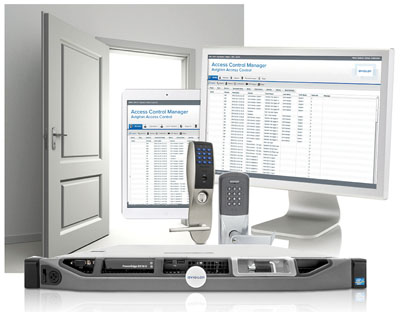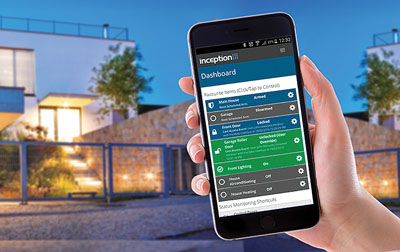On-going developments in the wider technological world have enabled smart solutions to increasingly leverage advances from a number of other industries and sectors. Even technological progress in the consumer market can be quickly realised in modern commercial systems. One such advance is the use of browsers as graphical user interfaces. This approach delivers a number of benefits for integrators and end users. Benchmark considers the use of browsers in access control systems.
In today’s rapidly advancing technological landscape, flexibility and ease of use are key features for any solution. Users have become accustomed to intuitive interfaces, and a growing number of smart devices are shipped without any manuals or support documentation because of this. Phones and tablets have created expectations when it comes to user interfaces, and people know how to navigate around their devices with ease. One interface that highlights flexibility, and which can also be used with both standard PCs and devices with touch screens, is the internet browser.
Due to the everyday use of internet services, plus the proliferation of browser-enabled devices, the knowledge-level amongst end users is very high when it comes to the humble browser. Additionally, every PC ships with pre-loaded browser software, and hardware often includes a number of choices. Additionally, browsers are free of charge.
The browser is effectively a basic form of display software. It simply interprets mark-up code and presents the various elements of a web page as specified. It is the elements displayed within the browser that the user interacts with, and because those elements are presented in the same way, regardless of the browser in use, users have a high degree of familiarity with the interface.
In the past, the use of browsers was somewhat restrictive as HTML code had certain limitations. However, as smart devices have become more popular, along with faster processors and higher data management capacities, so the need for a more interactive browsing experience came to the fore.
With the increased use of HTML 5, a wider range of features and functions became available. When used with various systems, these features allow a high degree of control and management, all accessed through the familiar architecture of a browser.
As other sectors adopt the use of browser-based interfaces with great success, it is inevitable that an increasing number of end users demand the same from their smart systems. As a result, the security industry has adopted similar approaches to other industries, including the IT sector, and the rise of browser-based access control interfaces deliver a more flexible option for the customer.
A flexible option
In recent years, the computing and communications sectors have invested significantly in the delivery of enhanced flexibility for users, and central to this has been an increased use of browsers. This is possible where a device hosts its own user interface on an integral web server, allowing users to access the software, manage settings and interact with the system without the need for dedicated servers or software.
 The flexibility of working in this way represents much more than remote interaction via a handheld device like a smartphone or tablet. Integrators can sometimes mistake customer demands for flexibility to mean they are seeking a smart system which supports switching or report generation via an app. Whilst such functionality is in demand from many businesses and organisations, it doesn’t represent the full picture.
The flexibility of working in this way represents much more than remote interaction via a handheld device like a smartphone or tablet. Integrators can sometimes mistake customer demands for flexibility to mean they are seeking a smart system which supports switching or report generation via an app. Whilst such functionality is in demand from many businesses and organisations, it doesn’t represent the full picture.
Today’s working environments are fluid. On many sites, the role of interacting with a smart system will often not fall to one dedicated operator. The days of the security manager or facilities manager are numbered as an increasing number of organisations leverage the benefits of advanced connectivity.
Various members of staff may have responsibility for building management tasks, along with a need to access or use the collected data for other business-related processes. This is especially true of an organisation’s access control system.
Multiple departments may need to interact with elements of the system for their own needs, alongside controlling access across the site. These can include receptionists and concierge services, human resources and payroll departments, health and safety compliance officers, asset management, car parking enforcement personnel, etc..
With traditional access control systems, dedicated software was required to interact with the solution. Because the software was licensed, it was typically installed on a limited number of workstations – sometimes a single PC – which were used to manage the access control system. This meant that either the other departments needed to pass requests for data or system access to the security team. The operators then had to interact with the solution via dedicated workstations hosting the software.
The other alternative was to set up regular reports which were sent to specific departments, if the software supported such functionality. This was fine for routine information, but wasn’t of use if data needed to be accessed for non-routine purposes, or real-time information was required.
Another issue with dedicated workstations was that this approach limited who could interact with the core system. If the authorised personnel were not on site, or could not directly access the workstation, then the system was effectively isolated. It became a smart solution that was unable to deliver smart benefits.
While remote connectivity via handheld devices can go some way towards alleviating this limitation, the reality is that interacting with the GUI of an advanced solution is not best managed via a smartphone. Apps can deliver benefits, but can themselves become constrictive if they are the sole point of interaction.
In order to open up the system to suit the users’ needs, an access control solution should be able to offer full functionality and control to any authorised person in any location via a range of devices. This demand is achievable today using newer access control systems.
The browser-based option
Many devices have integral web servers. If configurations are achieved over a LAN connection, then it likely that the device supports browser connectivity. This applies not just to system controllers, but also to individual field devices. Integral web servers enable system configurations, management and control of the device, and fluid connectivity via network-based infrastructure. Remote connections are achieved via WAN links, and local networks allow interconnectivity between various devices. The upside of this is that if the integrator or end user needs to connect to a specific device, either for set-up, maintenance or to retrieve data or reports, they can do so with ease if they have the right permissions. Connectivity can be realised from any network-connected device with a browser, without a need for dedicated software.
 Increasingly, this approach is being adopted by access control companies. Many already include integral web-servers in field devices, and increasingly the GUI is loaded onto a central controller. This allows control and management of the access control system to be achieved via a variety of devices.
Increasingly, this approach is being adopted by access control companies. Many already include integral web-servers in field devices, and increasingly the GUI is loaded onto a central controller. This allows control and management of the access control system to be achieved via a variety of devices.
Because the software which handles system configurations and management is loaded on the access system’s integral web-server, there is no need for dedicated workstations or licensed software. This reduces the total cost of ownership and enhances return on investment as there is no need for dedicated IT hardware. Installation costs are also reduced as the integrator does not need to install or maintain any core software applications.
This approach also has a number of positive implications with regard to software updates and bug fixes. Often such upgrades are managed by the integrator or in-house IT team, and can require the application of updates to every workstation running the dedicated software. With an integral web-server hosting the GUI software, a single firmware update to the system ensures that anyone logging in via a browser is automatically connected to the latest version of the GUI.
The use of a browser-based system allows configurations, administration tasks and operational interaction such as creating reports, handling alarms and adding or deleting users to be carried out from any compatible device on the network. The operational framework will retain a high degree of familiarity, as it is all managed in the familiar browser environment. Training demands are reduced for operators, enabling a more flexible approach to be taken to system management.
The level of flexibility on offer is significant for many businesses and organisations as the implementation of a browser-based user interface means that the access control system can be accessed immediately, from a wide range of devices, without any need to liaise with the security department or to involve IT managers. The lack of software management also removes the issue of down-time while installations or upgrades are carried out.
In terms of total cost of ownership, browser-based systems also deliver multiple-user support without the need for numerous licenses. While the cost of the interface will be included in the hardware, typically reflecting what the software would have cost, there are no multi-seat licences as the interface can be freely accessed.
Multiple site systems can be unified, with control managed in different geographical locations based upon time zones, personnel allocations, available resources and incident-handling expertise, again without additional software.
Browser-based systems can be web-based, cloud-based or local. The use of browser interfaces is not relevant to the overall system topology.
In summary
A browser-based access control solution delivers benefits with regard to user interaction, whilst simplifying installation and reducing licensing costs. Upgrades are easier and faster to implement, and remote connectivity is enhanced.
Browser-based solutions make sense in many applications, and integrators and end users should seek out the flexible solutions.







